There is no doubt that the popularity of air purifiers has been growing over the years, with people increasing their awareness of the importance of good air quality and, more than ever, searching for devices such as air purifiers.
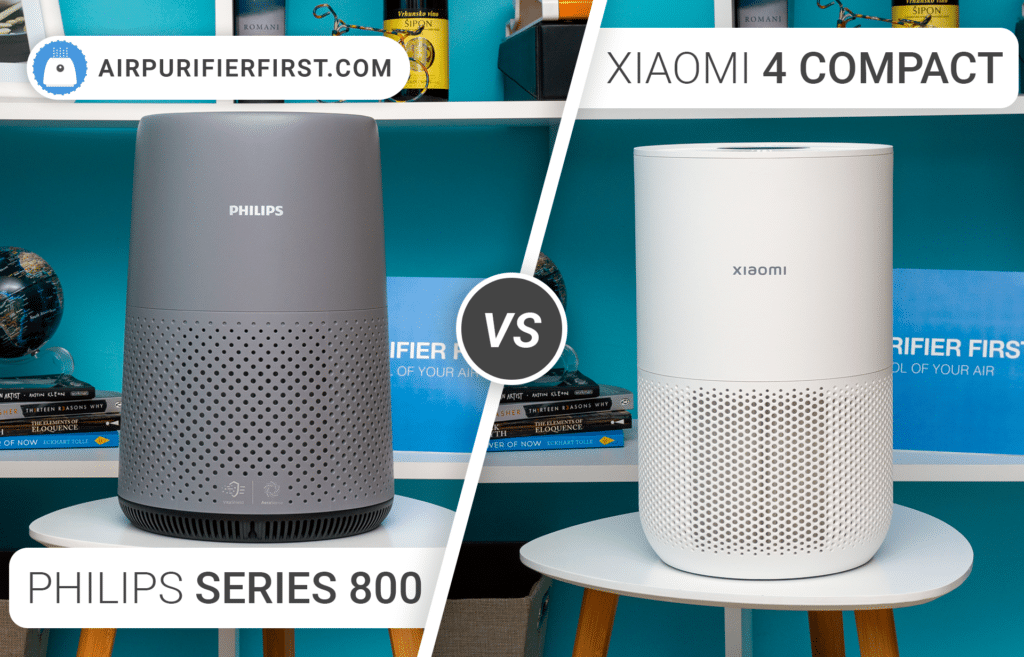
Table of Contents
The markets are flooded with small air purifiers, and choosing the one that suits you best could be challenging. In this review, I will compare two tiny air purifiers, Philips Series 800 and Xiaomi 4 Compact. Many people have heard of these two brands, so I won’t dwell on that; I’ll only say that these are reliable and very popular brands.
The Xiaomi 4 Compact stands out for its numerous advanced features and significantly larger room coverage. At the same time, the Philips Series 800 is defined by its modern look, minimalistic design, and user-friendly controls. The Xiaomi covers rooms up to 206 sq. ft., while the Philips covers rooms up to 176 sq. ft.
Both devices use three-stage filtration technology. However, Philips does not use a True HEPA filter, which is why I give a slight advantage to Xiaomi, in terms of filtration efficiency.
Please keep reading and find out which of these two air purifiers showed better performance, which is quieter, which is equipped with more features, and, of course, which one is our recommendation for purchase.
Philips Vs Xiaomi Specifications
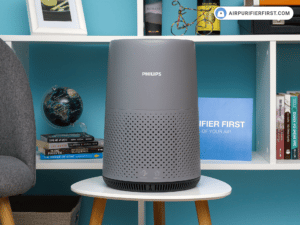 |
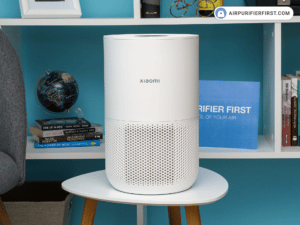 |
|
| Manufacturer | Philips | Xiaomi |
| Model | Series 800 (AC0830) | Compact 4 |
| Dimensions | 14.4 x 9.8 x 9.8 inches (36,7 x 25 x 25 cm) | Φ8.6 x 14 inches (Φ22.0 x 35.5 cm) |
| Room Coverage (4.8 ACH) | 176 sq. ft. | 206 sq. ft. |
| Performance Ratings | ||
| Filtration Technology | Pre-filter, NanoProtect HEPA Filter, and Activated Carbon Filter | Primary Filter, Xiaomi’s High Efficiency-Filter, and Activated Carbon Filter |
| Filter Replacement Indicator | Yes | Yes |
| Filter Longevity | up to 12 months | 6-12 months |
| Power | 20W | 27W |
| Operating Costs Ratings | ||
| Working Modes | 3 – Sleep Mode, Auto Mode, and Turbo Mode | 3 – Automatic Mode, Sleep Mode, and Manual Mode |
| Air Quality Sensor | Yes | Yes |
| Air Quality Indicator | Yes | Yes |
| Auto Mode | Yes | Yes |
| Smart App | No | Yes |
| Voice Control | No | Yes |
| Noise Levels | 41.8 – 62.8 dBA | 41.3 – 60.4 dBA |
| Noise Ratings | ||
| Warranty | 2-year | 1-year |
| In-Depth Review | Philips Series 800 | Xiaomi 4 Compact |
| Price | Check Price on Amazon | Check Price on Amazon |
Features Overview
Comparing Philips Series 800 to a Xiaomi 4 Compact in terms of features they have wasn’t as challenging as I expected. While Philips air purifier has some basic options, Xiaomi has some additional features that can be quite practical.
Control Panel
Some manufacturers like to keep it simple, which is an example of the Philips Series 800 air purifier. Way too simple, in my opinion. Once you press the Power button on the back side of the appliance, the main button on top serves mainly to switch between operating modes and as a Filter reset indicator.
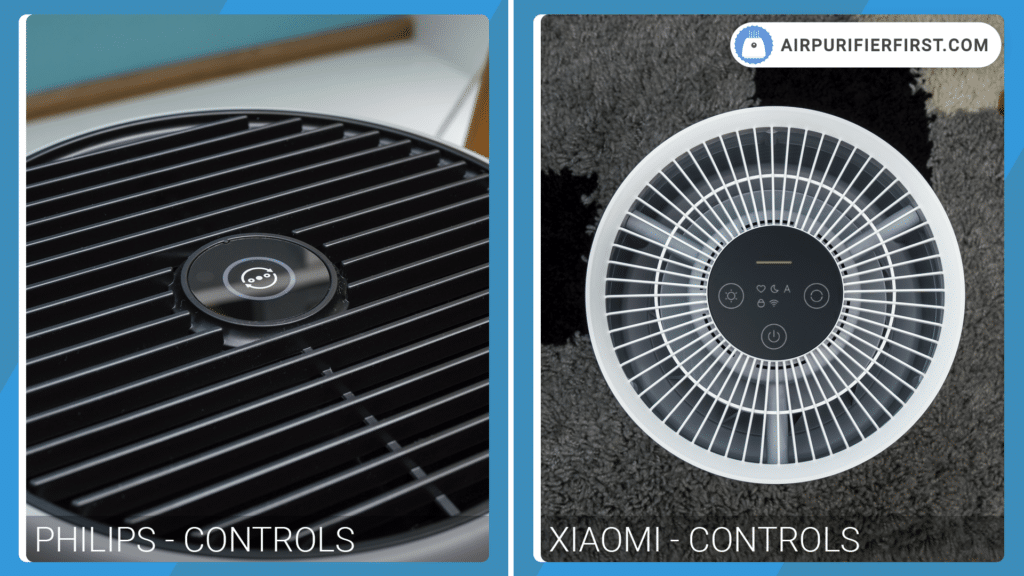
On the other hand, Xiaomi 4 Compact has more options controllable through the control board, such as the Power button, the Light adjustment button, and the Mode switch button. In addition, you will find a Child Lock, a Wi-Fi, and a Filter Reset indicator.
All these and many more options you can find as well, through Xiaomi Smart app, which will be discussed later on.
Air Quality Sensor and Air Quality Indicator
One of the first and most important features that Philips and Xiaomi have in common is the air quality sensor, accompanied by an air quality indicator. Both air purifiers have sensors located on the backside.
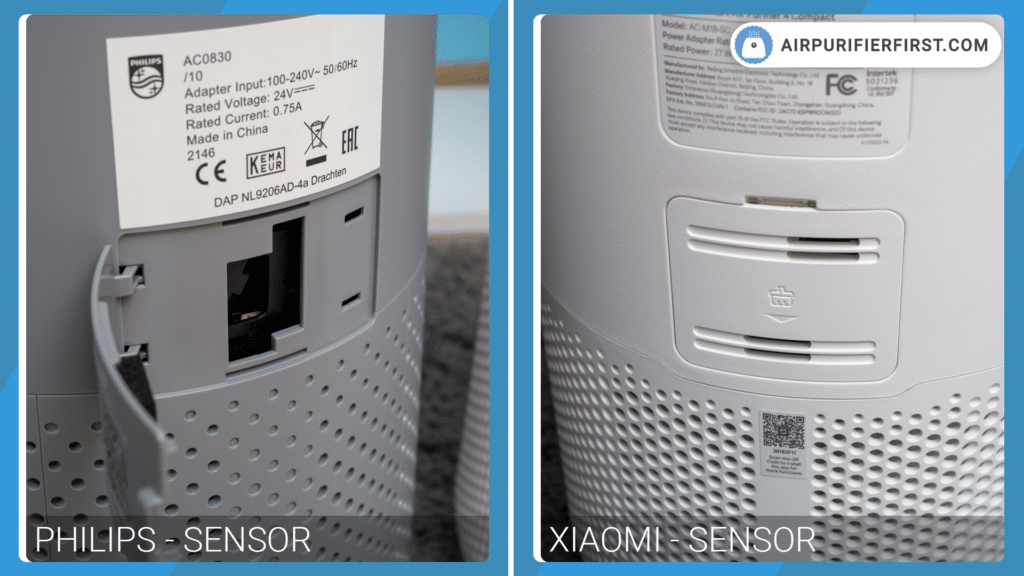
What differentiates the one from another is that Philips Series 800 has an ordinary yet extremely efficient air quality sensor, while Xiaomi 4 Compact has an IR (infrared) particulate matter sensor. Both sensors are collecting the data by detecting the real-time amount of PM2.5 particles. The Xiaomi 4 Compact even has a sensor that runs on its own motor, which means it collects data even when the air purifier is shut off.
Like in many other air purifiers, the air quality sensor works jointly with the air quality indicator and the auto mode. This indicator is essentially a LED light that changes color based on the pollution information provided by the sensor. You can see it straight on both devices and track color changes by yourself.
Auto Mode
One of the great advantages of having an automatic mode is the ability to turn ON the air purifier, set the auto mode, and leave it safely running while you do your daily tasks. The air purifiers Philips Series 800 and Xiaomi 4 Compact have this feature in common, which is a great deal, trust me.
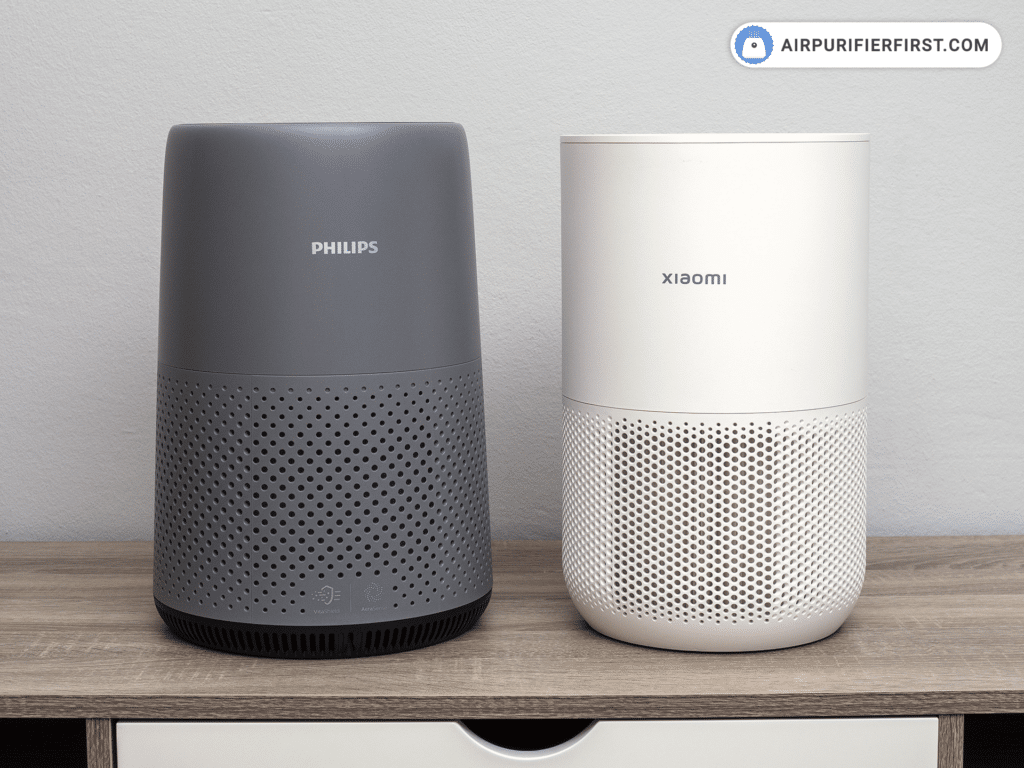
Once the air purifier is set to Auto mode, it will constantly be on guard by switching operating modes and fan speeds according to the current air quality in the room.
Filter Reset Indicator
As with many other air purifiers, at some point, you will need to reset the filter within. This time variates from one device to another, however, there is always a good reminder to help you on the way. Filter reset indicator is the feature available at both Philips and Xiaomi air purifiers.
This indicator is located at the top of both devices and lights up when the time comes to replace the filter. While Xiaomi 4 Compact filter lasts between 6 and 12 months, Philips Series 800 usually lasts up to 12 months.
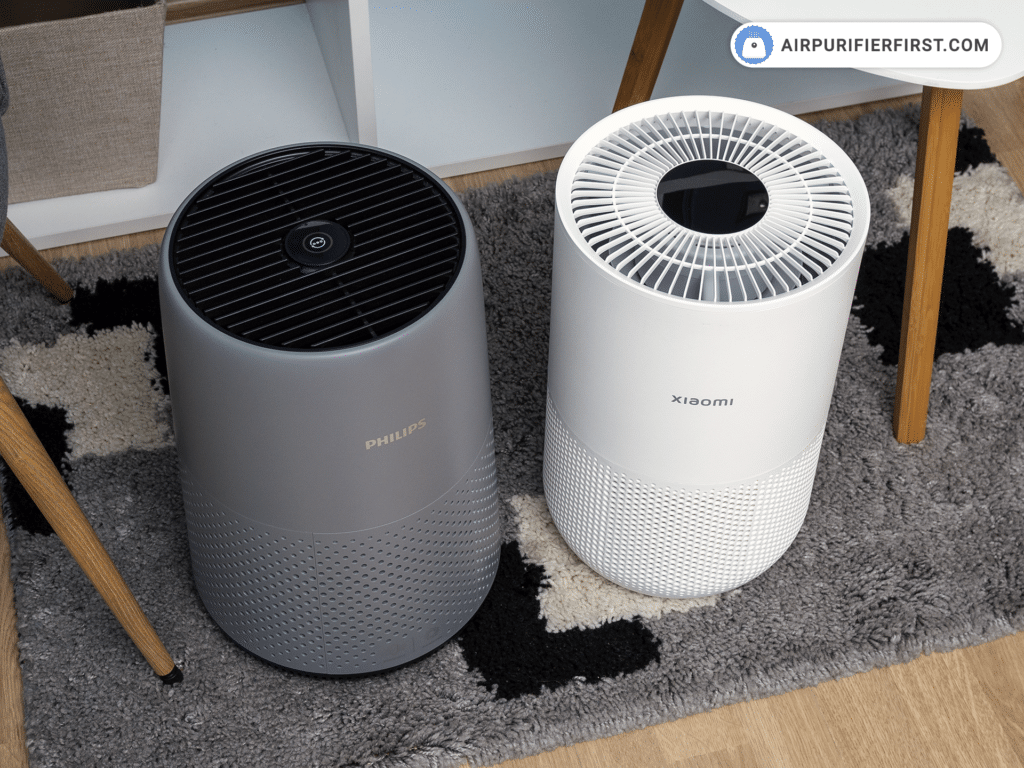
The extra value for the end user provided by the Xiaomi air purifier is the possibility to keep track of the filter exhaustion through the Mi Home app.
Sleep Mode
The Sleep Mode is a great feature to bear in mind if you wish to use the air purifier in your bedroom during the night. Both comparing air purifiers have this option integrated as one of the speed modes and I must admit that Philips and Xiaomi are satisfyingly silent while on this mode.
Manual Mode
If you’ve read some of my previous Xiaomi reviews, you might already assume that the Manual mode is available within Xiaomi 4 Compact, and you would be right. It is available only through the Mi Home smart app. What you need to do, is to set the desired operating mode by using the smart app, and then turn on the Manual mode on the control panel. This way, the air purifier will continuously be operating the way you set it up.
Light adjustment
One of the features that the Xiaomi 4 Compact has and the Philips Series 800 doesn’t is the light adjustment system/button. With a single button press, you can gradually adjust the brightness of the indicators on the air purifier.
All indicator lights can be dimmed completely, except the Power button which is partially dimmable. You can find this button on the control board.
Mi Home app
Available only within the Xiaomi ecosystem, Mi Home is a universal app that any Xiaomi device can be connected to. This app provides a unique control system over all Xiaomi home appliances, from any place and at any time.
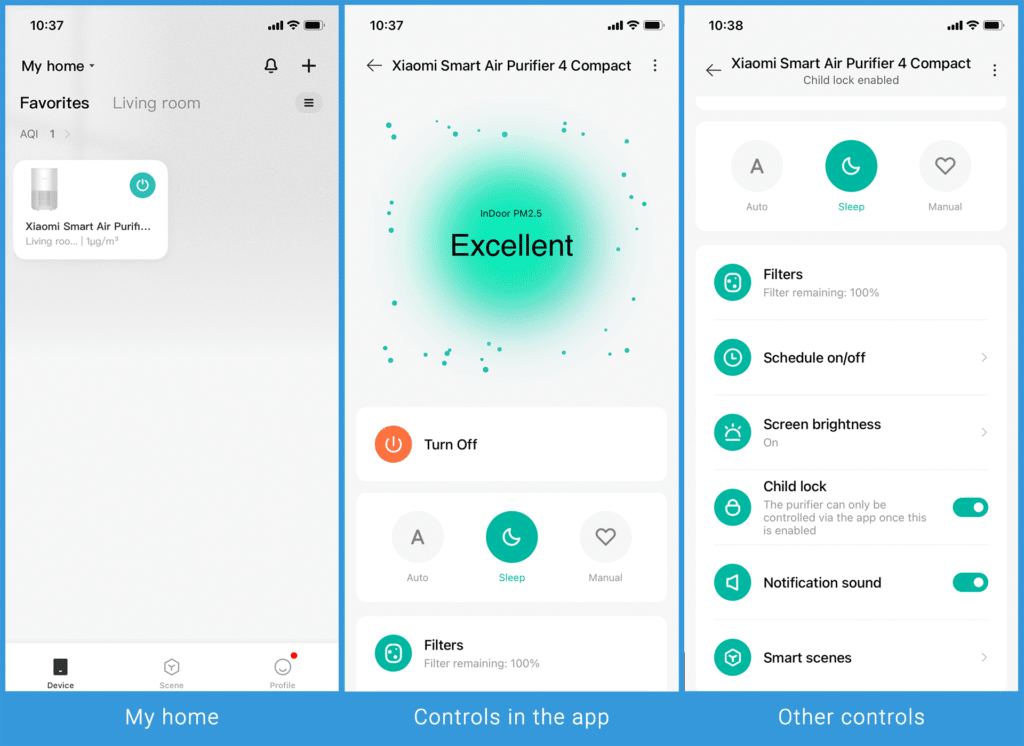
It is easy to navigate and well-designed to make your life simplified. If you need more information on how to use this App specifically for the Xiaomi 4 Compact, you can find it here.
Lock Screen
The lock screen option, or the Child lock as we usually like to call it, is an option available only within Xiaomi 4 Compact, straight through the Mi Home smart app. By activating this feature you will completely lock up the air purifier, at the same time protecting it from any kind of disturbance or interference.
Airflow
Most likely, when two comparing devices are cylindrical, you’d think they also share the way the air flows. In this particular case, you would be right. The Philips Series 800 and the Xiaomi 4 Compact have filters stored in the lower part as well as air inlets.
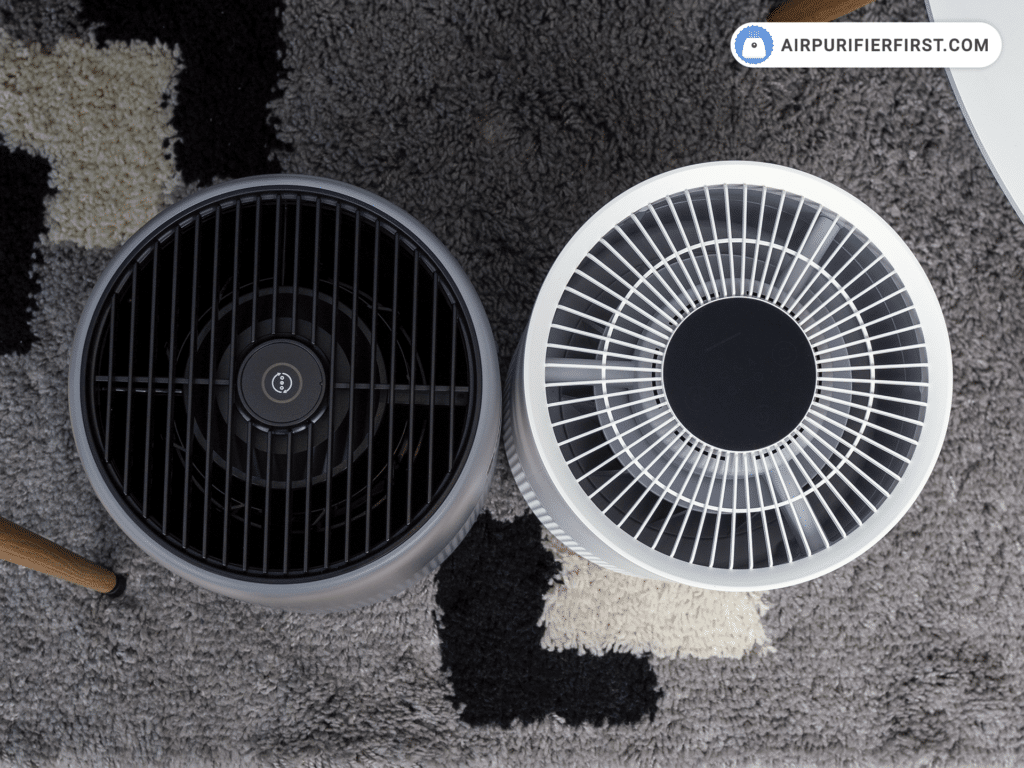
Both devices have air inlets arranged all over the case, whereas suction holes collect the polluted air, which later on gets purified through the filtering process and dispersed through the upper side holes.
Warranty
Fixing unexpected issues that can come up with any type of device can sometimes be a real challenge. Never underestimate the power of good warranty coverage by the manufacturer. Recognizable as it is, the Philips company provides a 2-year warranty, and you are covered worldwide. Contrary, the Xiaomi manufacturer provides only a 1-year of warranty, which I don’t think is good enough for such a fast-growing company.
Filtration Technology
The filtration process is the essential process within any air purifier system. Depending on what filters they have and of which quality, the final result will be approvable or not.
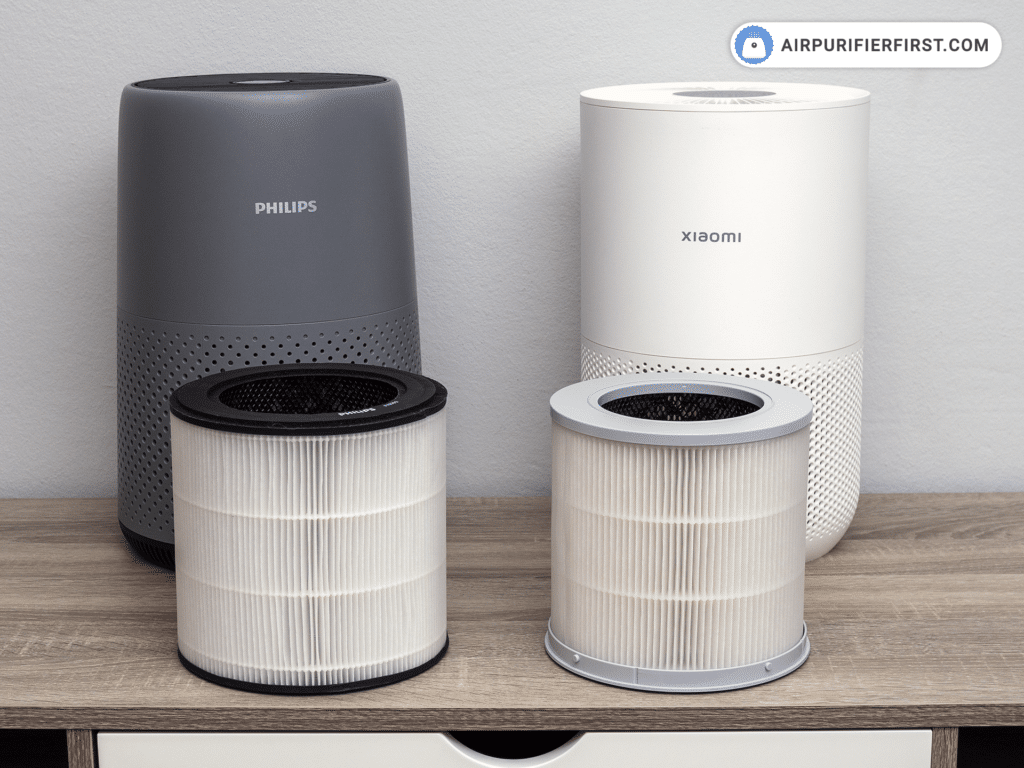
As I expected, each purifier has a very good filtration system integrated, consisting of three levels of filtration. In the first and the third place, each air purifier has a pre/primary and an activated carbon filter, respectively. The situation changes for the second filtration stage, where Philips Series 800 has a NanoProtect HEPA filter, while Xiaomi 4 Compact has a High-Efficiency filter (equivalent to a True HEPA filter). Let us take a closer look.
The first level, as I said, belongs to the primary line of defense. This means that in the case of Philips, as well as the Xiaomi air purifier, this filtration level is used to trap a variety of larger dust particles, hair, pet hair, pollen, dust, etc. Since this filter is meant to protect the next one in line, you should pay attention and keep it clean with occasional dusting or gentle vacuuming.
The second filtration level of Philips Series 800 belongs to a special NanoProtect HEPA filter, responsible for capturing dust particles, varied allergens, pollen, and plenty of other particles, leaving highly improved air quality.
The High-Efficiency filter taking second place in Xiaomi’s filtration process is capable of trapping 99.97% of particles as small as 0.3 microns, such as dust, pollen, smoke, and pet odors. Each producer’s air purifier has shown great performance, despite not having a True HEPA filter as their core filter. More about it in the Performance section.
For the last stage of filtration, both air purifiers have activated carbon filters. The main purpose of these filters is to neutralize all of the unpleasant odors that could come from all sources like smoke, cooking, etc. Also, the Philips and the Xiaomi air purifiers have pellet-based filters, whereas the Philips device comes with some more carbon, resulting in stronger odor removal.
How to replace filters on both of these devices?
Many users think that replacing the filters is a difficult job to do but it isn’t so. It’s usually way more simple. One of the most important things you need to remember is that the Philips series 800 nor Xiaomi 4 Compact don’t have washable filters. That means you will have to use a cleaning mop or a vacuum cleaner to maintain the functionality of your air purifier.
As I already mentioned the Xiaomi air purifier has a filter that can last between 6 and 12 months, while at the same time filter within the Philips air purifier can last up to a year.
Either way, both air purifiers have a filter reset indicator which means you will be notified when it’s time to replace the filter.
Performance Tests
As I mentioned in the intro, the Xiaomi air purifier covers rooms up to 206 sq. ft., while the Philips covers up to 176 sq. ft.
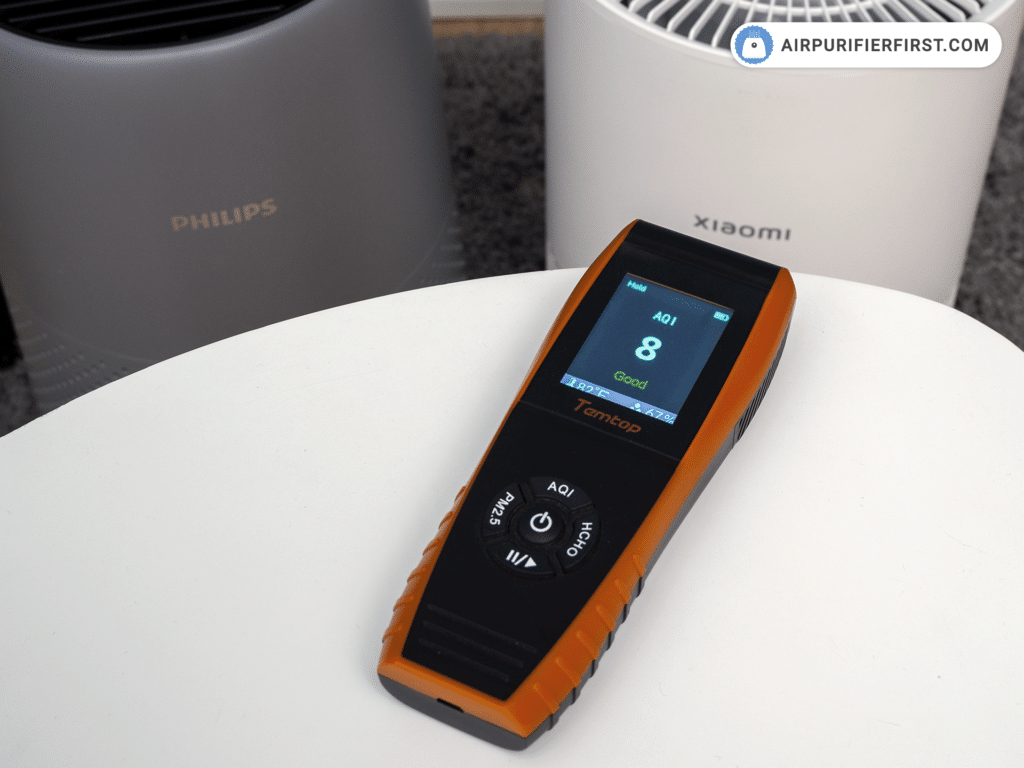
To conduct this comparison, I decided to perform two separate tests that lasted approximately 60 minutes each, during which both air purifiers were exposed to their maximum speed level. Here are the results.
194 sq. ft. Room Tests
As you can see, the Phillips series 800 air purifier has been tested in a larger room because I wanted to see the capabilities of this device. I was blown away by the effectiveness and 93% air improvement rate. On the other hand, the Xiaomi for compact had a slightly better result with a 94% rate. This was expected for the Xiaomi air purifier, yet a surprise for the Phillips.
194 sq. ft. Room
* Data measuring time is 60 minutes.
320 sq. ft. Room Tests
For the testing, I used a quite larger room size to see if either air purifier would stand out. The result got me shocked. By 91% improved air as a result of both Phillips and Xiaomi air purifiers was more than satisfying, because neither device wasn’t designed to cover such a large room.
320 sq. ft. Room
* Data measuring time is 60 minutes.
As for the end note, I think you can figure out by yourself that Phillips Series 800 air purifier gets to win in this combat, but only for a point. The thing is, this air purifier has shown tremendous power to significantly improve the quality of the air in twice as much room size than a manufacturer’s specification.
Noise Tests
If there is one characteristic that could be used to describe both Philips and Xiaomi air purifiers that would be an ear-friendly appliance. This means the noise level produced by each ear purifier would never be a deterrent for you to make a purchase.
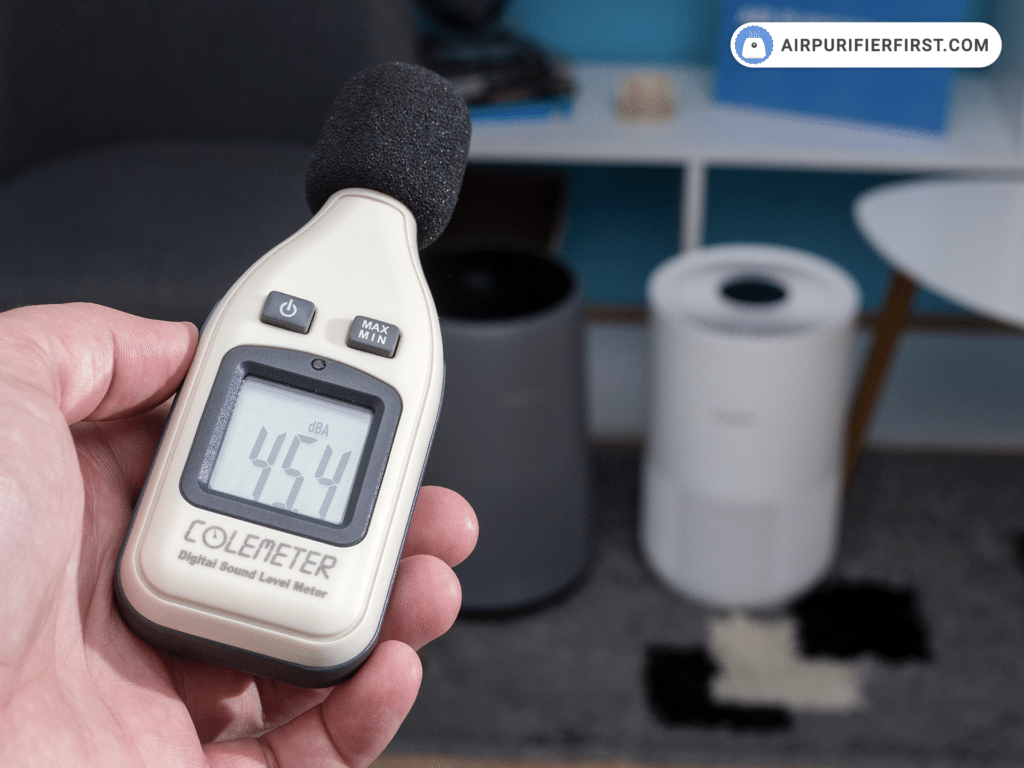
So, each air purifier has two basic operating modes. A Sleep mode and a Turbo/Max speed mode. In addition, each producer’s air purifier has an Auto mode whose noise variates between the two speeds. I must admit that both air purifiers are surprisingly and extremely silent while running in sleep mode, with a slight advantage in favor of the Xiaomi air purifier. While this air purifier produces 41.3 dBA, a Philips air purifier produces slightly more, 41.8 dBA. Either way, both air purifiers are safe to use in a bedroom during the night, and trust me you won’t even notice them.
| Product | Noise Range (dBA) |
|---|---|
| Philips Series 800 | 41.8 – 62.8 dBA |
| Xiaomi 4 Compact | 41.3 – 60.4 dBA |
The difference between these two products becomes more obvious once you turn on the maximum speed. With 60.8 dBA produced, Xiaomi 4 Compact is noticeably quieter than the Philips Series 800 and the 62.8 dBA it makes.
Even though it feels as if Xiaomi air purifier has a better score than Philips in my opinion it’s a tie.
Operating Costs
As these two air purifiers are around the same size, therefore, it doesn’t come as a surprise that they share similar motor power. The Philips air purifier has 20W of motor power while the Xiaomi 4 Compact comes with a slightly higher power of 27W.
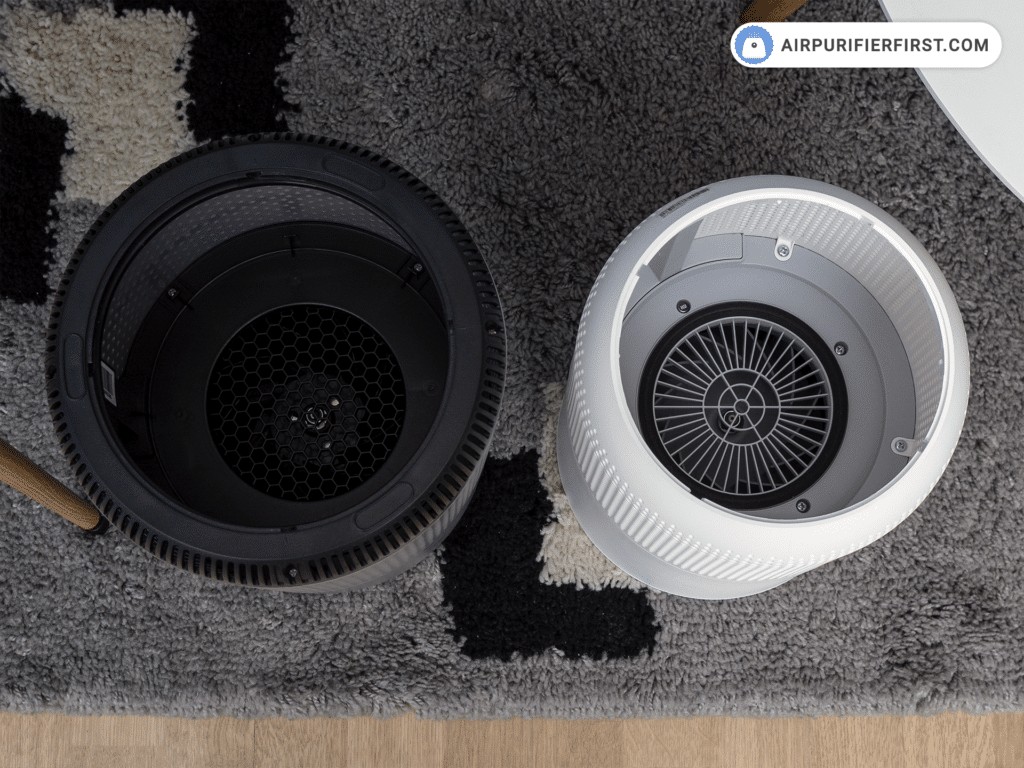
From the user’s point of view, the initial product price is what seems to count the most at first. In this case, Xiaomi 4 Compact seems like a better solution since its price is lower than the Philips series 800 air purifier.
Another important thing that counts is the price of the filter replacement. The Xiaomi air purifier does have a cheaper filter, but if we consider that it would take approximately two times a year to do the filter replacement, the logical conclusion would be that the filter replacement of the Philips air purifier would be a more affordable solution.
The third important factor when judging the affordability of an air purifier is the total monthly cost, which in this case, runs in favor of the Philips air purifier. If you leave both air purifiers running 24/7 for a whole month, by the end of the period, you will have $1.60 electricity bill with the Phillips air purifier while having a $2.10 with the Xiaomi product at the same time.
| Product | Wattage Range (W) |
|---|---|
| Philips Series 800 | 2.2 – 17.5W |
| Xiaomi 4 Compact | 1.8 – 24.2W |
All this brings us to a summary that the Phillips series 800 takes a tiny victory in this cost-effective battle. Nevertheless, it is a light advantage, which is why buying a Xiaomi air purifier wouldn’t be a much more expensive option.
Philips Series 800 Vs Xiaomi 4 Compact – Video Comparison
Which One Is Better?
This was a very tight battle, and it was a bit challenging to determine which one would take the winning stand. However, details such as advanced options, smart features, larger room coverage, and a True HEPA filter, are the reasons I chose the Xiaomi 4 Compact as the winner in this comparison.
Although the Philips Series 800 won some tests and is slightly quieter, the nuances and some personal preferences were deciding factors in this comparison.
Essentially, this comparison could have been a draw; however, in every comparison, I try to choose a winner and thus make a choice easier for future buyers of air purifiers. If you have questions regarding these two air purifiers, feel free to write in the comment box below.
Leave a Reply